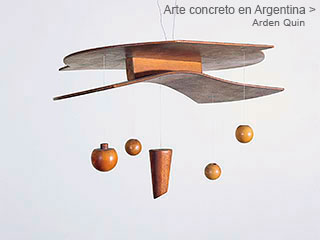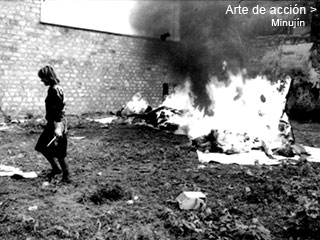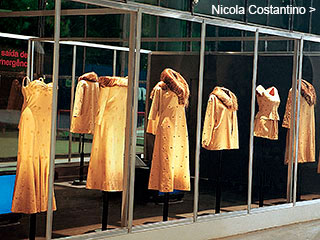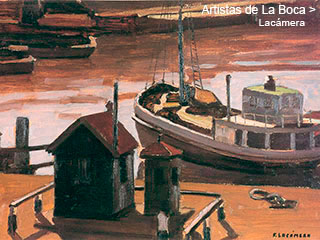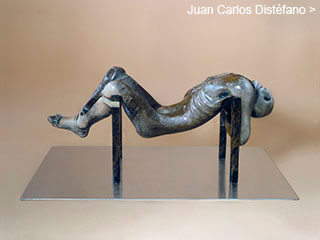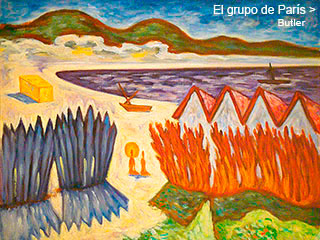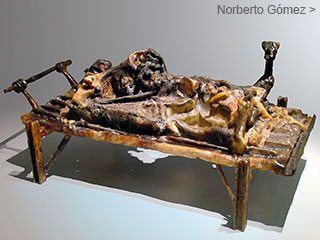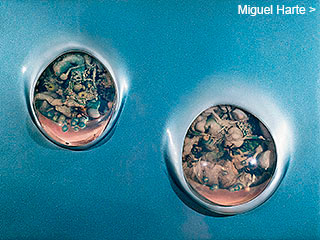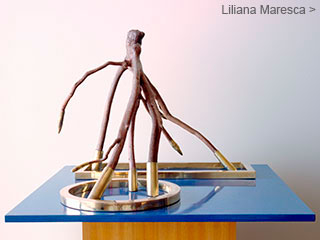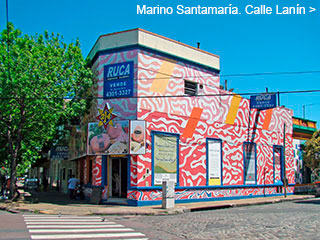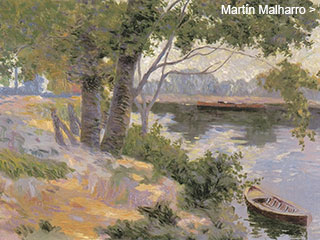Menú
Algunos dossiers
Concrete Art
in Argentina
in Argentina
by
Adriana Lauria
January 2003
January 2003
Abstraction asserted itself in Argentina through the achievements of groups such as Arte Concreto-Invención, Madí and Perceptismo, which developed their activity since the second half of the 1940s. These groups constituted the first organized national avant-garde and made their aesthetics known to the public through exhibitions, magazines, manifestoes, leaflets, lectures, etc.
Arturo magazine
The concepts “invention” and “trimmed frame” are essential to portray the movement originated with the issuing of Arturo magazine, and are perhaps its most original contributions.
Arden Quin discussed about invention in Arturo’s first article. He analyzed invention from the point of view of dialectic materialism as a stage surpassing figuration and he rose against Expressionism, Surrealism and any form of Realism. He stated, “invention becomes rigorous, not in the aesthetic means, but in the aesthetic goals. This, naturally, first implies imagination arising in all its contradictions; and then implies consciousness arranging imagination and depurating it from any representative, naturalist image […]”. 
In 1936 Torres García had already referred to invention, speaking about those movements that install new art styles, such as Impressionism or Cubism.  In Arturo they insisted upon the concept, trying to identify it as an aesthetic method, appealing even to dictionary entries, which, in the way of mottos, could be read at the cover backings of the magazine.
In Arturo they insisted upon the concept, trying to identify it as an aesthetic method, appealing even to dictionary entries, which, in the way of mottos, could be read at the cover backings of the magazine.
Tomás Maldonado.
Xilography for
Arturo’s covers
Xilography for
Arturo’s covers
Tomás Maldonado
Xilography for Arturo
Xilography for Arturo
Lidy Prati
Vignette for Arturo
Vignette for Arturo
An engraving by Tomás Maldonado illustrated the cover and in the inner pages were seen several vignettes by this artist and by Lidy Prati. There also were essays and poems by Edgard Bailey, Gyula Kosice, Torres García, Vicente Huidobro and Murilo Mendes, and reproductions of works by Vieira Da Silva, Torres García, Augusto Torres, Kandinsky, Mondrian and Rothfuss.
This last one closed the magazine with an article in which he speculated about the attributes of the enclosure frame. After making a synthesis of the history of modern art in its way to non-figuration, Rothfuss posed the question of the "traditional window frame", which maintained a predisposition to see in a picture an opening towards a simulated reality. He said about this, “a painting with a regular frame provokes the foreboding of a continuity of the subject, which disappears only when the frame is rigorously structured according to the painting’s composition. That is to say, when the canvas’ edge plays an active role in the plastic creation […]. A painting must be something that begins and finishes in itself.” 
The “trimmed frame” contributed to the intent to evade the fictionality of the image, stressing the presence of pure plastic components. This procedure had a background in works of the Hungarian Làzlo Peri and of Jean Arp; in Argentina and Uruguay it generated a prolific line of investigation and works of significant interest among the members of the different groups in which this first nucleus would divide. It is still used today, especially among the Madí artists and it has an influence on the work of many of the new generations’ abstract artists.
In an essential book for the study of Argentine Concrete art, Nelly Perazzo accurately sustains,
“What makes the (Arturo) magazine transcendental in our milieu is its nature of violent rupture with all the previous stages, its keenness for novelty, for confronting itself with the international avant-garde’s expectations, its youthful confidence in the need to become interpreters of their time and in the might of their contribution, its interdisciplinary concerns and for having served as a starting point to an extraordinarily relevant orientation in our country until these days”. 
Confrontments and ruptures
Grete Stern. Photograph taken during the Art Concret Invention exhibitionat the house of psychoanalyst Enrique Pichón Rivière
Arturo bore a belligerent tone that quickly dyed the artist’s manifestations, toughening up their stances. A situation of continuing deliberation, which later was carried abroad, formerly affected the internal front, as shown by the events in 1945.
In October, a multidisciplinary show called Art Concret Invention took place at the house of psychoanalyst Enrique Pichon Rivière. Ramón Melgar, Juan Carlos Paz, Esteban Eitler, Rhod Rothfuss, Gyula Kosice, Arden Quin and Valdo Wellington were part of it.
Grete Stern. Photograph taken during the exhibition held at her house by the Movimiento de Arte Concreto Invención
During December, at Grete Stern’s house in Ramos Mejía, the show Arte Concreto Invención Movement took place, including Elizabeth Steiner, Arden Quin, Rothfuss, Klaus Erhardt and Kosice, among others. Alfredo Hlito and Raúl Lozza did not contribute with their works for they agreed with the discrepancies sustained by Maldonado, though some photographs record their attendance.
The divergences among Arturo’s founders are not wholly clear, but it can be assumed that Maldonado wished to oppose a more rigorous and purist aesthetics to the ecumenical synthesis deriving from the teachings of Torres García. Arden Quin would not leave these completely aside, in spite of having opted for an abstract art, which dispended with the sign figurations held by the Constructive Universalism.
There also were discrepancies in their aesthetic programs. The Asociación Arte Concreto-Invención was to stick to the plastic-visual expressions, extending their principles to architecture and design, and sharing with these disciplines their project-based method. Instead, the movement headed by Arden Quin, Rothfuss and Kosice that since 1946 would be known as Madí, intended to comprise every art in its operating field: music, dance, literature, and architecture in addition to painting and sculpture, presenting a versatile, dynamic profile, which praised transformation and motion.
This splitting would not end with the divergences. Raúl Lozza resigned to the Asociación in 1947 and together with his brothers and the art critic Abraham Haber created Perceptismo as an ambit to give place to their theoretical differences about the use of the trimmed shapes.
About that time, the Madí movement also split because of a dispute –still unsettled– between Arden Quin and Kosice. Seemingly, the latter issued the No. 0 of Madí magazine, using the contents that were meant to be employed in Arturo’s No. 2, which did not succeed to reach printing. Consequently, Arden Quin came apart from him, followed by Martín Blaszko. Rothfuss remained together with Kosice and they both prompted the Madí’s activities in Buenos Aires and Uruguay. Arden Quin traveled to Paris, where he would later take up residence, and from there he impelled the diffusion of Madí, transforming it into an international movement still active in our days. 
The battling spirit that lead to these early cracks showed in the tone of the manifestoes, leaflets and publications, establishing an authentic avant-garde movement profile. The constitution of groups, the principles statements and their recurring theoretical validations, the constant involvement in aesthetical debates, where certain impugning violence was exerted, indicated a new stage in the fastening of the abstract language in the nation that so far had expressed itself through isolated emergences. It is perhaps the strength of the shared convictions –in spite of very subtle disagreements– what allowed the abstract tendency to install itself in Argentina and evolve, turning out to be the starting point of fruitful art practices to come.


